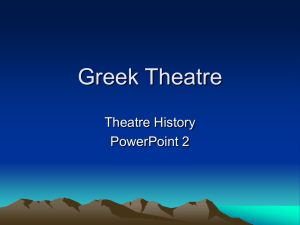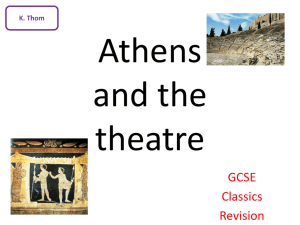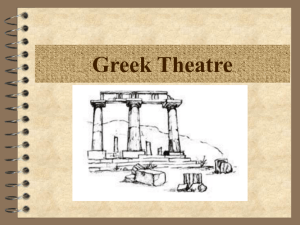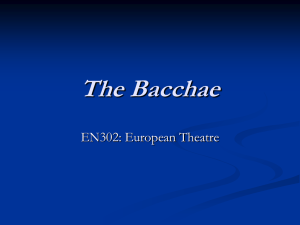Ancient Greek Theater
advertisement
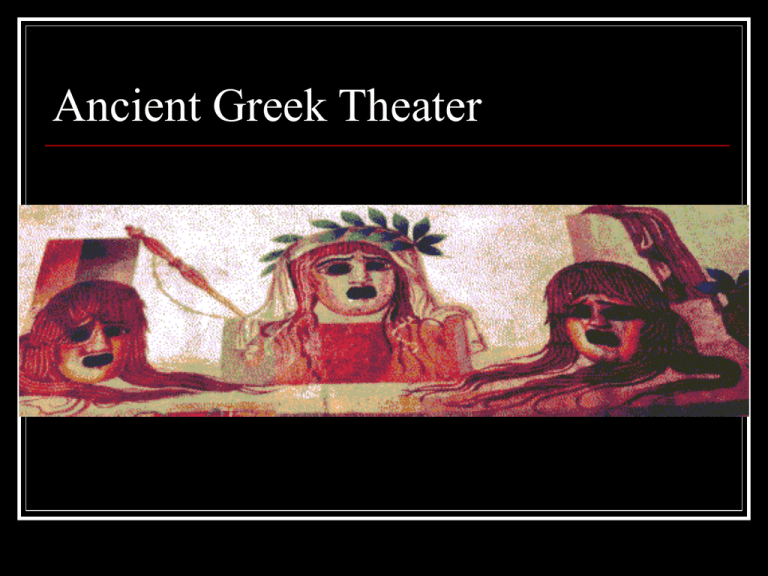
Ancient Greek Theater This is where it all began: the Theatre of Dionysos in Athens. According to legend, late in the sixth century BCE a man named Thespis first had the idea to add speaking actors to the performances of choral song and dance which occurred on many occasions throughout Greece. (That's why actors are sometimes called 'thespians'.) Masked actors performed outdoors, in daylight, before audiences of 12,000 or more at festivals in honor of Dionysos, the god of theatre. The comedy and tragedy that developed in Athens and flourished in the fifth and fourth centuries BC have influenced nearly all subsequent Western drama, starting with that of the Romans. When the Romans conquered Greece they brought Greek literature back to Italy and set about making it their own. The Romans, with their love of spectacle, soon took over the existing theatres in Greece and began renovating and rebuilding them for their own spectacles, which included everything from pantomime (closer to ballet than to the children's 'panto') to mock naval battles. Most of the remains of the theatre of Dionysos which we can see in Athens today date to Roman times and not the fifth century BC. The tragedies and comedies of the fifth and fourth centuries BC that remain to us today were almost all written for performance in the Theatre of Dionysos at Athens. The Theatre of Dionysos was first dug out of the slope beneath the south side of the Acropolis in the late 6th century BC. The Precinct The Theatre of Dionysos was only one part of the precinct of Dionysos. Initially, the precinct contained only the Older Temple of Dionysos and a sacrificial altar. Later a hall, or stoa, was added, incorporating the Older Temple, and a second temple built further south. The highest row of seats in the Theatre of Dionysos was 125 feet above the lowest part of the precinct, and before the construction of the stoa and the stage building (skene), the audience could easily see the temples and the sacrificial altars from the theatre. More importantly, from the Athenian point of view, Dionysos himself (represented by his cult statue, which was seated in the front row) could observe not only the choral performances being given in his honor but the sacrifices which were made at his altar. The Precinct Pericles also introduced the Theoric Fund to subsidize the cost of theatre tickets for the poor. The price of a ticket to the Theatre of Dionysos was two obols, as much as a laborer earned in a day. The Players Because Greek tragedy and comedy originated with the chorus, the most important part of the performance space was the orchestra, which means 'a place for dancing' (orchesis). A tragic chorus consisted of 12 or 15 dancers (choreuts), who may have been young men just about to enter military service after some years of training. Athenians were taught to sing and dance from a very early age. The effort of dancing and singing through three tragedies and a satyr play was likened to that of competing in the Olympic Games. In contrast with the chorus of 12 or 15, there were only three actors in fifth-century Athenian tragedy. The original word for 'actor' was hypokrites, meaning 'answerer,' for the actor answered the chorus. Thespis is said to have introduced (and been) the first actor, later called protagonistes (literally 'first competitor'). The introduction of a second actor is attributed to Aeschylus and the third to Sophocles. Four Qualities of Greek Drama Occurred during special occasions or festivals Competitive. Prizes offered for best plays Use of Chorus; involved singing Closely related to religion Seven Qualities of Greek Tragedy Late Attack Violence/death occurs offstage Use of messengers to relay information Continuous time of action Setting is a single place Based on myth or history Focus is on psychological, not physical or sociological Greek Theater Masks Masks The large size of the theatre (in its final form it seated 20,000 people) and the distance of even the nearest spectators from the performers (more than 10 meters) dictated a nonnaturalistic approach to acting. All gestures had to be large and definite so as to 'read' from the back rows. Facial expression would have been invisible to all but the closest members of the audience; the masks worn by the actors looked more 'natural' than bare faces in the Theatre of Dionysos. The masks of tragedy were of an ordinary, facefitting size, with wigs attached, and open mouths to allow clear speech. Contrary to some later theories, there were no 'megaphones' in the masks, and their decoration and expression was quite subtle, as vase paintings from the 5th and 4th centuries attest. Theatrical masks were made of wood (like the masks of Japanese Noh drama), leather (like the masks of the Commedia dell' arte, or cloth and flour paste (like many of the masks used at the Carnival of Venice, and many masks made for modern productions today). Various theories are advanced in favor of each material, but no originals remain, only stone carvings which may have been used as mask-molds and the paintings on pottery. Each set of three tragedies was followed by the performance of a satyr play, a short spoof of a myth related to the theme of at least one of the tragedies. The ordinary human characters in these plays wore tragic masks and costumes, but the chorus of half-human satyrs wore pugnosed, pointy-eared, bearded masks, and furry shorts. The masks of Greek Old Comedy were distorted caricatures, sometimes of real people. They were meant to be ugly and silly in keeping with the ludicrous padded costumes worn by comic actors. While tragic actors wore elaborate pattern-woven garments which were similar to the robes of priests and musicians.

